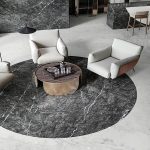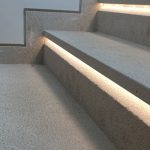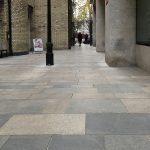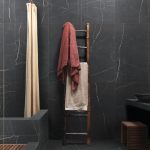Polish to Bring Back Marble Glory

Polish to Bring Back Marble Glory
Polish to bring back marble glory. This is what we have heard. But how can we polish marble? Stay with us if you are looking for the answer.
Marble Sophistication
Marble tops offer a sophisticated, durable alternative to Formica, laminate and wood. Many antique pieces, such as old washbasins, have marble tops, as do coffee tables, mantels and other furnishings. Whether you’ve chosen marble tops, rented an apartment that has one or you have inherited a marble top, cleaning it properly will help it last a lifetime or longer. To make a marble top shiny, polish it after cleaning. If it’s especially dirty or stained, you might need to apply a poultice or sand it. Sealing a marble top after cleaning or sanding helps give it a shine.
Marble Polishing an Easy Task
Normal wear and tear and the use of harsh chemical cleaners can dull marble. Polishing marble is an easy task that you can do as often as once a month to keep your marble looking lustrous. While you can find a variety of commercial products to polish your marble, you can also make your chemical-free version with items you may already have in your home. In between polishing, keep marble looking its best by dusting it with a dry mop or cloth, and cleaning up spills immediately.
Marble Significance
Marble a white or uniquely variegated type of limestone that has been exposed to extreme heat and pressure has a long history of being favored by artisans and builders, from Michelangelo’s David and Moses sculptures to The Taj Mahal. So it’s no wonder that marble in the modern home is both prized and expensive. Its natural beauty, depth of pattern, and unique markings make it an elegant, luxurious choice for flooring, countertops, tabletops, and vanities.
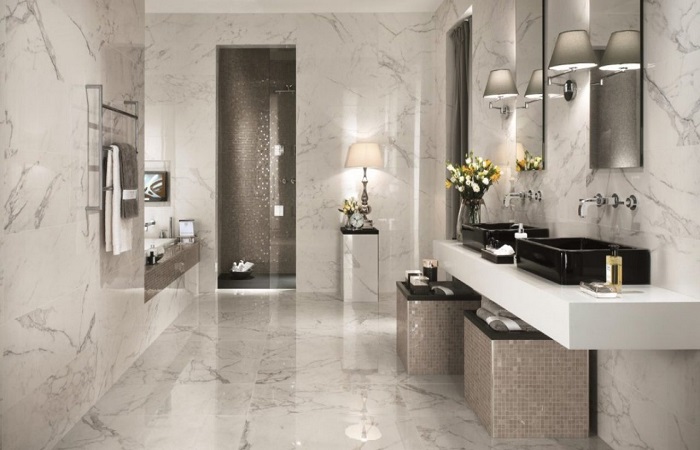
Marble Etching
However, soft and porous marble counters have their downsides, and chief among them is their tendency to stain or etch. The latter problem, etching, refers to dulled spots that sometimes appear pitted and feel slightly rough to the touch. These may occur after exposure to acidic or highly colored foods (red wine, tomatoes, vinegar, and citrus) and even acidic or abrasive cleaning products. While a matte marble finish can minimize the appearance of imperfections, the glossy finish that most homeowners prefer on their countertops often shows off every etch and stain.
Polish to Bring Back Marble Glory
Still, the beauty of marble and the value it adds to your kitchen or bathroom makes it worth a bit of extra trouble. When your marble surfaces have lost their shine, the following procedures will bring back the glory of this classic stone.
Honed or Polished Marble?
Before tackling the cleaning and shining of your marble counters, it helps to understand the two different marble finishes before you fruitlessly try to restore shine to one that’s not designed to be glossy.
Honed Marble
Honed marble has been sanded to create a velvety finish not quite matte, but not shiny. Less slippery than polished marble, honed marble is very well suited for floors. Some homeowners also prefer honed marble for their countertops, as it’s less likely to scratch than polished marble and hides etching better than a shiny surface.
Polished Marble
Still, polished marble is the more common choice for the kitchen countertops or table inlays. The less porous option, this finish won’t stain as easily as honed marble might and does not demand the same frequency of sealing. Plus, its shine offers a semi-reflective surface that is both attractive and helps to make a small kitchen appear larger than its footprint.
Transform Polished to Honed Marble
While it is possible to transform a polished marble counter into a honed surface, or vice versa, the project requires skill and experience and special equipment. In other words, it’s best to leave this job to a professional with a stone polishing machine. If you’re looking to restore shine to your polished marble counter or tabletop, though, you can do so with these accessible supplies and steps.
How to Polish Marble
Following steps are suggested to polish marble.
Start with a Clean Slate
Brush off crumb and dust particles, spray with a mild cleanser, and wipe. The first step to restoring your marble’s shine is to clean them. Of course, you probably whisk away crumbs regularly and quickly wipe up any spills or splatters, but when it’s time to polish up your marble’s finish, you’ll go a little deeper than that.
Remove Dust and Crumbs
Wipe your marble with a soft dry rag to remove dust and crumbs, then wet the surface with a damp sponge.
Apply an Approved Marble Cleaner
Next, apply a manufacturer-approved commercial marble cleaner or add a couple of drops of mild, non-abrasive dishwashing liquid to your damp rag to use as a cleaner. Whichever you choose, distribute the cleaner across the marble, buffing away any spots of food or other debris. Never use vinegar, bleach, scrubs, or other harsh chemicals to clean your polished marble. Doing so can etch the polish, leaving you with dulled spots.
Wipe the Cleaner Off
Use a clean, damp rag, wipe the cleaner off the marble. Dry with a chamois or an unused microfiber cloth.
Make Poultice to Remove Stains
If your marble counters have discolorations left behind by food or other household items, you’ll need to treat them before moving on to polishing. While there are commercial marble stain removers often called poultices you can also make your own by slowly mixing one tablespoon of ammonia into a half-cup of hydrogen peroxide and slowly adding just enough baking soda to make a thick, creamy texture.
Apply the Poultice
Now, spread the poultice over any stained areas using a clean paintbrush and cover with plastic wrap. Leave the poultice in place for 12 to 24 hours, after which you can remove the plastic wrap and leave to dry out completely. Carefully scrape the crumbly poultice away with a razor blade without gouging or digging at the marble surface. Clean away any remaining poultice residue with a damp cloth, and then wipe the marble dry.
Remove Minor Etching with Polishing Power
While very severe etching requires a professional’s touch, you can often remove minor etching from acidic foods and cleansers yourself with a polishing powder from any old home improvement centers. But, make sure to check with the marble manufacturer on which they recommend.
Sprinkle Marble Polishing Power
Wipe the etched areas with a water-dampened cloth, and sprinkle a small amount of marble polishing powder onto the etched spots. Gently buff the powder into the blemishes with your damp cloth according to the product’s instructions. Follow with a clean, damp rag to remove the powder residue, then wipe the marble dry to reveal its restored shine.
Seal the Marble for Shine and Resistance
While sealing won’t completely prevent staining, this act will help your marble resist major stains and boost its glossiness. Generally, you should seal your marble counters at least twice per year, although performing the task each season will keep your counters looking their best. Consult your countertop’s manufacturer for product and application recommendations specific to your marble.
Spread the Sealer across the Entire Marble
Read the directions on your marble sealer carefully, and apply as directed. Most specialty marble sealers spray or pour directly onto the marble’s surface. Spread the sealer across the entire marble countertop with a clean, dry cloth and let the sealer soak into the marble for the length of time specified on the product’s container, typically less than five minutes.
Buff the Sealer into the Marble
Use another clean, dry cloth to buff the sealer into the marble, using circular motions. Continue to buff the marble until the sealer is completely soaked into the stone, and the marble feels dry. If the surface has a tacky or sticky feel, continue to buff until the marble is smooth to the touch, and has a high level of shine.
Wipe the Marble with a Dray Cloth
Wipe the marble top with a soft, dry cloth to remove any surface dirt and debris. Weta non-abrasive sponge with warm water, wring it out and wipe the marble top again. Spray the marble surface with commercial stone cleaner and wipe it off with a clean, soft rag. As an alternative, add a drop or two of mild dishwashing liquid to the damp sponge, wipe the marble top and rinse well with plain water, or use a solution of one part hydrogen peroxide to two parts water.
Dry the Marble Top with a Cloth
Dry the marble top with a chamois cloth. Buff, it to shine by rubbing the entire surface with the cloth in small circles.
Cover the Surface with Stone Polish
Cover the surface with commercial stone polish or marble-polishing paste if you want more shine after buffing with a chamois. If using a spray-on stone polish, wipe with a soft rag. Mix 2 tablespoons of ammonia and 1 cup of hydrogen peroxide in a bowl.
Make a Thick Paste
Pour enough hydrogen peroxide into the powder to make a thick paste, stirring as you go.
Spread the paste over the stain on the marble top with a spatula or putty knife.
Cover the Paste with Plastic Wrap
Cover the paste with plastic wrap and tape around the edges with masking tape or painter’s tape. Allow the poultice to dry for 24 hours and scrape it up with a razor blade. Wash the marble top with water to remove any remaining powder.
Sanding
Spray the marble top with water both before sanding and during the sanding process to keep the surface wet. Place a piece of 120-grit sandpaper on the pad of a palm sander. As an alternative, use sheets of sandpaper or a sanding block and sand the marble top by hand.
Wipe the Marble with a Damp Sponge
Sand the marble top in a circular motion. After going over the entire surface with 120-grit sandpaper, repeat with 300-grit sandpaper, then 600-grit. Wipe the marble with a damp sponge to remove sanding dust.
Seal the Marble if Desired
Seal the marble, if desired, with a commercial sealing product. The Marble Institute of America states that there are a number of different types of sealers, so choose an oil-repellent sealer with at least a 10-year life expectancy. Use the sealer according to the package directions.
Confusion and Misunderstanding
It’s easy to see why this issue creates such confusion and misunderstanding. The long and short is that whatever finish you want on your marble (shiny, flat, rough, rustic) it is originally done at the factory, by a skilled professional prior to installing, or as a marble repair. Again, a finish can be changed once installed, but that is a demanding job that requires special abrasives, tools and the skill of an experienced stone restoration professional. It’s not a DIY job… not even for the handiest of handymen. Also, any finish type you find on marble (say in an existing home you purchase) is likely the original finish.
Final Conclusion
If it is dull or honed, then likely that’s the way it is supposed to be, and it doesn’t need polishing. Although it could have been etched by using the wrong marble cleaning products, that’s the only time it ever needs marble polishing. Of course, if you’d rather have a shiny polished finish, then you can have a honed surface polished into a shine by a professional, but there is nothing wrong with the honed floor.
Or if the damage and etching are over a large area of flooring or an entire countertop, it may be best to consult a stone restoration professional.
To learn more about us, click here.
Send your price quotes directly to our WhatsApp through this Link: https://wa.link/ord5k8
Sources
cmpstone.com.au/how-do-you-polish-marble/
Article
Natural Stone Applications
- 22 December 2022
Iranian Stones Introduction According to Source and Quarry
- 21 December 2022
Technical Stone Introduction and Quarrying Procedures
- 21 December 2022
Categories
- blog757
- news1
- Specialized articles756




